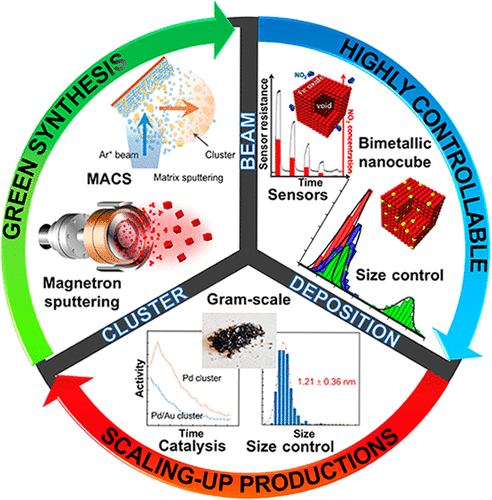当前位置:
X-MOL 学术
›
Acc. Chem. Res.
›
论文详情
Our official English website, www.x-mol.net, welcomes your feedback! (Note: you will need to create a separate account there.)
Synthesis without Solvents: The Cluster (Nanoparticle) Beam Route to Catalysts and Sensors
Accounts of Chemical Research ( IF 18.3 ) Pub Date : 2018-09-06 00:00:00 , DOI: 10.1021/acs.accounts.8b00287 Richard E. Palmer 1 , Rongsheng Cai 1 , Jerome Vernieres 1
Accounts of Chemical Research ( IF 18.3 ) Pub Date : 2018-09-06 00:00:00 , DOI: 10.1021/acs.accounts.8b00287 Richard E. Palmer 1 , Rongsheng Cai 1 , Jerome Vernieres 1
Affiliation

|
It is hard to predict the future of science. For example, when C60 and its structure were identified from the mass spectra of gas phase carbon clusters, few could have predicted the era of carbon nanotechnology which the discovery introduced. The solubilization and functionalization of C60, the identification and then synthesis of carbon nanotubes, and the generation and physics of graphene have made a scale of impact on the international R&D (and to some extent industrial) landscape which could not have been foreseen. Technology emerged from a search for molecules of astrochemical interest in the interstellar gas. This little sketch provides the authors with the confidence to present here a status report on progress toward another radical future—the synthesis of nanoparticles (typically metals) on an industrial scale without solvents and consequently effluents, without salts and their sometimes accompanying toxicity, with minimal prospects for unwanted nanoparticle escape into the environment, with a high degree of precision in the control of the size, shape and composition of the nanoparticles produced and with applications from catalysts and sensors to photonics, electronics and theranostics. In fact, our story begins in exactly the same place as the origin of the nanocarbon era—the generation and mass selection of free atomic clusters in a vacuum chamber. The steps along the path so far include deposition of such beams of clusters onto surfaces in vacuum, elucidation of the key elements of the cluster–surface interaction, and demonstrations of the potential applications of deposited clusters. The principal present challenges, formidable but solvable, are the necessary scale-up of cluster beam deposition from the nanogram to the gram scale and beyond, and the processing and integration of the nanoclusters into appropriate functional architectures, such as powders for heterogeneous catalysis, i.e., the formulation engineering problem. The research which is addressing these challenges is illustrated in this Account by examples of cluster production (on the traditional nanogram scale), emphasizing self-selection of size, controlled generation of nonspherical shapes, and nonspherical binary nanoparticles; by the scale-up of cluster beam production by orders of magnitude with the magnetron sputtering, gas condensation cluster source, and especially the Matrix Assembly Cluster Source (MACS); and by promising demonstrations of deposited clusters in gas sensing and in heterogeneous catalysis (this on the gram scale) in relevant environments (both liquid and vapor phases). The impact on manufacturing engineering of the new paradigm described here is undoubtedly radical; the prospects for economic success are, as usual, full of uncertainties. Let the readers form their own judgements.
中文翻译:

无溶剂合成:簇状(纳米粒子)到达催化剂和传感器的路线
很难预测科学的未来。例如,当从气相碳簇的质谱图中鉴定出C 60及其结构时,很少有人能预测发现所引入的碳纳米技术时代。C 60的增溶和功能化碳纳米管的识别和合成,以及石墨烯的产生和物理性质对国际R&D(在一定程度上是工业)格局产生了无法预料的影响。在星际气体中寻找对天化学感兴趣的分子的技术应运而生。这个小草图使作者充满信心地在这里提出了有关另一个根本未来的进展的状态报告-工业规模的纳米颗粒(通常是金属)的合成,不含溶剂,因此没有废水,不含盐,有时伴随有毒性,且具有最小限度的毒性在尺寸控制方面具有高度精确性的有害纳米颗粒逃逸到环境中的前景,产生的纳米颗粒的形状和组成,以及从催化剂和传感器到光子学,电子学和治疗学的应用。实际上,我们的故事始于与纳米碳时代起源完全相同的地方-真空室中自由原子团簇的产生和质量选择。迄今为止,沿着这条路径的步骤包括在真空中将此类簇束沉积到表面上,阐明了簇与表面相互作用的关键元素,并演示了所沉积簇的潜在应用。目前面临的主要挑战是巨大而可解决的,是簇束沉积必须从纳克级放大到克级甚至更大,以及将纳米团簇的加工和整合到适当的功能结构中,例如用于非均相催化的粉末,这是一个艰巨而可解决的挑战,即配方工程问题。本报告通过簇生产(以传统的纳克规模为例),强调尺寸的自选,非球形形状的受控生成以及非球形二元纳米颗粒的实例说明了解决这些挑战的研究。通过磁控溅射,气体冷凝簇源,尤其是矩阵装配簇源(MACS),将簇束的生产规模放大了几个数量级;并通过在相关环境(液相和气相)中在气体传感和非均相催化(以克为单位)中进行沉积簇的有前途的演示。毫无疑问,这里描述的新范例对制造工程的影响是巨大的。与往常一样,经济成功的前景充满不确定性。
更新日期:2018-09-06
中文翻译:

无溶剂合成:簇状(纳米粒子)到达催化剂和传感器的路线
很难预测科学的未来。例如,当从气相碳簇的质谱图中鉴定出C 60及其结构时,很少有人能预测发现所引入的碳纳米技术时代。C 60的增溶和功能化碳纳米管的识别和合成,以及石墨烯的产生和物理性质对国际R&D(在一定程度上是工业)格局产生了无法预料的影响。在星际气体中寻找对天化学感兴趣的分子的技术应运而生。这个小草图使作者充满信心地在这里提出了有关另一个根本未来的进展的状态报告-工业规模的纳米颗粒(通常是金属)的合成,不含溶剂,因此没有废水,不含盐,有时伴随有毒性,且具有最小限度的毒性在尺寸控制方面具有高度精确性的有害纳米颗粒逃逸到环境中的前景,产生的纳米颗粒的形状和组成,以及从催化剂和传感器到光子学,电子学和治疗学的应用。实际上,我们的故事始于与纳米碳时代起源完全相同的地方-真空室中自由原子团簇的产生和质量选择。迄今为止,沿着这条路径的步骤包括在真空中将此类簇束沉积到表面上,阐明了簇与表面相互作用的关键元素,并演示了所沉积簇的潜在应用。目前面临的主要挑战是巨大而可解决的,是簇束沉积必须从纳克级放大到克级甚至更大,以及将纳米团簇的加工和整合到适当的功能结构中,例如用于非均相催化的粉末,这是一个艰巨而可解决的挑战,即配方工程问题。本报告通过簇生产(以传统的纳克规模为例),强调尺寸的自选,非球形形状的受控生成以及非球形二元纳米颗粒的实例说明了解决这些挑战的研究。通过磁控溅射,气体冷凝簇源,尤其是矩阵装配簇源(MACS),将簇束的生产规模放大了几个数量级;并通过在相关环境(液相和气相)中在气体传感和非均相催化(以克为单位)中进行沉积簇的有前途的演示。毫无疑问,这里描述的新范例对制造工程的影响是巨大的。与往常一样,经济成功的前景充满不确定性。



























 京公网安备 11010802027423号
京公网安备 11010802027423号